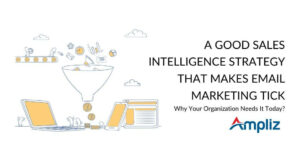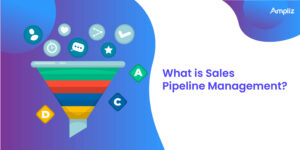Sales Strategy is all about creating a need. Having an effective sales strategy is bliss. The right sales strategy means you are creating the right kind of environment for revenue generation.
By this, what I meant was you are sending the right message at the right time that resonates with your prospects, they trust you and choose to buy from you.
For sales to happen organically, the critical ingredient in your sales strategy is building a brand that your customers can trust.
According to the Brevet Group report, only 13% of customers trust salespeople. The more you have customer’s trust, the more your business will expand.
Increase customer trust by manifolds through the implementation of the right sales strategies.
A good sales strategy will enable your sales team to understand the customers and take the right action that will act as an embrocation for their pain points.
Before delving deeper into this topic, let’s understand first, “what is a sales strategy?”
What is a sales strategy?
Well, in simpler terms, it’s a business’s distinctive strategy for sales of its products or services to its target market.
But realistically, at a granular level, a sales strategy is all that can benefit businesses in creating better revenue generation opportunities.
And the reason establishments use multiple sales strategies that operate at the different stages of their buyers’ buying journeys.

For example, once a lead is in contact with a salesperson, a few select sales strategies can be invaluable. Whereas, once a prospect has already converted, they will need different sales strategies to encourage the customer into repeat business.
Companies often take the most common sales strategies and adapt them to suit their product or industry.
“A sales strategy is a business’s cohesive and planned methodology for selling framed into an actionable strategy.
Sales strategies are characteristically driven by explicit underlying principles based on a corporation’s competitive advantages, to procure new clients and cultivate existing ones.
It doesn’t matter your sales team is five or 500 people; an excellent sales strategy is crucial to being able to close contracts swiftly and unsurprisingly.”
How do you develop a sales strategy?
While developing a sales strategy, the obvious goal would be growth in revenue generation. The sales strategy should be planned by keeping below these key elements in mind:
- Goal
- Relevant market/audience
- Buyer Persona
- Product offering
- Performance measurement
- Sales activities
While strategizing the action plan, the first thing you need to keep in mind is the “Goal.” Set it with the time frame, such as the number of sales or the revenue you need to generate from sales for Q1, Q2, Q3, and Q4.
You need to do market research to find the target audience. By including this factor in your strategy will help you to get more sales.
Knowing your Buyer’s persona is the most significant element in the sales funnel. Have at least the bare minimum information about the customers like name, position, company, estimated age, and others. It will provide you with ideas about your customers’ interests and needs.
Followed by the customer profile, the product offering is another crucial phase of the sales strategy.
However, customer profiles provide fair ideas if your product is suitable for them or not.
The last two elements (performance measurement and sales activities) belong to the internal strategies.
Implement them inside the sales team. Observe the performance of the sales team and find the points that will empower them to be active.
Plan the sales activities according to their accomplishments.

Different Types of Sales Strategies
Sales strategies might not and should not be the same for all organizations even if the products belong to the same niche.

Different types of strategies work for different companies and it depends upon the nature of business.
Here is the list of effective sales strategies:
- Start with specific niche markets
- Use lead scoring to prioritize your prospects
- Connect with the decision-makers
- Make your sales pitch exciting
- Listen to your prospects
- Emphasize the risks and opportunities
- Develop the right mindset
- Go beyond business
- Reach out to SQL immediately
- Follow the PAS framework
- Target your Existing customers
- Make the prospect realize that it is a final offer
- Employ email automation
- Keep track of customers’ records
- Organize Healthy competition within the sales team
- Strengthen your Buyer’s persona
- Have a clear understanding of your clients
- Bring the USP to your customers with a free trial
- Align your sales and marketing team
- Run sales offer unexpectedly
1. Start with specific niche markets
The sales strategy starts with targeting the right audience. Depending on the market size and accessibility to the target audience, you have three choices.
Firstly, target all the geographies and specific audiences.
Secondly, particular geographies and one specific audience.
Lastly, drill down to the most resonating and accessible audience in geography and target them effectively and efficiently.
Moreover, it is the most efficient sales strategy to target a particular audience initially, such as the company that has small employee size, specific location, and industry.
This practice will open the door to pitch and implement your plan.
Most of the marketers don’t want to target the small scale industry as they think it will limit the opportunity, but the fact is that you will be able to train your sales team according to the feedback you receive from your client. Moreover, you should consider automating presales enablement to streamline processes and ensure efficient operations.
If you target prominent and well-known industries, it will not only be challenging to have feedback about your sales team, but also, the conversion may diminish.
It is always better to target a specific niche market.
2. Use lead scoring to prioritize your prospects
Lead Scoring is a good strategy where leads to deal conversion ratio is low.
In this case, the business concerned generates enough leads; however, it fails to convert the majority of them. The main reason for a situation like this is premature leads.
The premature prospects are the ones that fit the target audience but have failed to have enough number of interactions with your brand.
While handling a considerable volume of leads, positioning the lead scoring into your sales strategy is a must. Score the interactions with your prospective client positively or negatively. It helps provide you the idea to whom you need to prioritize.
Lead Scoring is a system to rank your prospect and score him/her. As per the score, you can follow up and send reminders.
For instance, you are connecting with a new prospective client who is a decision-maker, and you need to prioritize him to nurture.
Decide the lead score based on the activities per prospect’s position, timeline (how soon s/he needs the product), type of solution, and other activities.
3. Connect with the decision-makers
In the realm of B2B sales, a decision-maker occupies a vast arena. Therefore, targeting decision-makers should be a part of the B2B sales strategy.
If you are connecting a manager who doesn’t have authority, it is kind of a waste of time for your sales team. Target the decision-makers to throw your baits.
Another remarkable point in the B2B sales field is the way you approach. The approaching method to a customer (B2C) is entirely different from the approaching process to a decision-maker (B2B).
So, train your sales team with probable questions to be asked by the decision-makers with the cautious answer.
Make a note of not limiting your sales strategy by connecting with the right decision-maker and encountering his/her challenging questions.
Building a long-lasting and a thriving relationship by understanding his/her pesky problems and providing possible solutions beyond your products and nurture him in a regular interval.
Make sure that the relationship is beneficial for both of you.
4. Make your sales pitch exciting
A salesperson earns their living by speaking. They thrive on their oratory skills. A salesperson needs to keep improving their oratory skills.
Almost all the sales personnel train themselves in online research skills.
Finding information about your prospect is one of the critical skills a good salesperson has. Combine both the expertise, and you get excellent sales pitching capabilities.
Utilizing an event staffing agency to help you find the perfect salesperson to help your business reach its goals in another possibility.
Speaking with customers and building a relationship is an art. All sales reps may not have this art. To uplift their skills, train them on an effective sales pitch.
Categorize the types of customers (or clients) and prepare the script for each category.
When it comes to pitching sales, bring your unique selling points without rattling off your existing customers and experiences.
The first 90 seconds of your conversation is called the “elevator pitch.” Stress yourself to show the prospects that you understand their challenges and provide the solution for their pain point within the elevator pitch.
5. Listen to your prospects
Salespeople are a talkative lot.
Listening is key to building great relationships, and critical to building a successful career.
Communication is a two-way path. Not only you have to speak well, but also you have to listen carefully.
Remember this “Communication leads to conversations; conversations lead to conversions.”
Effective communication happens when both parties listen to each other and respond accordingly. Heeding to your leads will help you understand prospects’ interests and expectations.
Most of the sales reps stress on particular points such as price, benefits of the products or services, the example of existing customers, and other kinds of stress factors.
Instead of understanding the customer’s problems and providing the solution.
This way of approaching the products/services throws the picture of compelling to the prospects for the products.
Therefore, include active listening to your clients in your skillset as one of the most significant factors in the sales strategy.
To learn about their pain points, you could consider having cloud contact center software in place.
6. Emphasize the risks and opportunities
Don’t chase all prospects and don’t run away from taking certain risks.
Choosing which opportunities to pursue and what risk to consider is a virtue very few salespersons have. Experience in making sales over the years can only give such insights.
A salesperson can not only understand this but also help customers understand the risk to return paradigm.
Highlighting risks and opportunities is one of the most effective ways to strengthen sales growth.
While conversing with the prospect, bring the trending challenges and its probable risks, find possible solutions for their problems, including your products and services.
Also, don’t hesitate to let them know the risk of having your products or services.
It will give them a picture that you are pretty much aware of the problems they are going to face, and you have the solution for it.
If they don’t think this way, they will not go for your product. It is better than withdrawing later.

7. Develop the right mindset
Most of the sales reps lose their patience by experiencing the rejections. The significant sales technique is to develop the mindset of your sales team not to consume the rejections.
Once you plan sales call for the day, you need to set your mind that you are going to hear “no” multiple times.
Instead of getting disappointed, train yourself to shift focus to the next lead.
According to Tony Robbins, the business strategist, and philanthropist, a successful business has 80% determination (Psychology) and a 20% plan.
Therefore, developing the right mindset is one of the most effective sales strategies.
Therefore, the question here arises is what is the right mindset. There is no defined answer to it. It varies from person to person based on their tenacity and risk appetite.
Perseverance helps them face rejection and handle tougher situations while having the right risk appetite can help to choose the right opportunities.
8. Go beyond mere business
The “Being helpful” concept always provides the trust relationship. While trying to sell the product, understand the lead’s problem, and see if your product or service can help him/her.
If not, be helpful, go beyond the business, and suggest the proper solution. It may not provide you a sale at that moment, but trust will be there.
Being helpful and humane is good to have. Providing all kinds of assistance and aid for your customers is good to have. Make sure that you don’t go overboard.
Align your business goals and being helpful to your customers. It is this alignment that will build a trusting relationship as well as grow revenue drastically.
Do not forget to share your stories as well as ask your customers to share their stories.
When word spreads about this kind of customer-buyer ties, you will gain the leads’ referral or regain the same lead when s/he needs help from you. This cycle can be further enhanced through strategic use of referral links, facilitating continued connections and potential leads within your network.
9. Reach out to SQLs immediately
In sales, time is of the essence. Be it reaching out to your qualified leads, or reaching out to your customers for upselling or cross-sell opportunities.
Reaching out to the prospects in the first few hours of qualification has higher chances of closing the deal. Never sound desperate, but the early bird catches the worm.
Once you have all the information about a Qualified Sales Lead (SQL) if possible reach out to him/her immediately or within 24 hours.
Most of the buyers do a plethora of research on the product they want. If you don’t reach out to the SQL early, s/he may encounter your competitors’ calls.
One of the most effective strategies is to reach out to the SQL within 24 hours and give him/her a picture of your product or services that will be helpful for him/her.
Your initial outreach email should be short and precise and ask permission to schedule a call within a day.
10. Follow the PAS framework
As per Perry Marshall, author of “80/20 Sales and Marketing”, talking about the problem can deliver 3 to 10 times more responses than talking about products and services.
When you highlight the problems and possible risks behind it, people will listen to you carefully.
The PAS framework associated with the three steps:
P – Problems
A – Agitation
S – Solutions
According to this framework, stress on the problems your prospect is having and highlight the risks behind it.
Finally, position your product or service as his/her best solution. Your sales strategy should include this concept to enable your sales growth.
Followed by the above information, I want to highlight that this is not to scare a lead by creating false problems and risks.
Sales team creating a sense of urgency, uncertainty, and loss is not lying to the customers. Do not blow up the issues beyond measure.
Be genuine and make them realize the problems, risks, and bring them solutions.
11. Target your existing customers
Acquiring new customers is 12 times costlier than retaining existing ones. Current customers have a 60-70% deal closing rate while new leads only have a 5-20%.
To hunt the new prospects, most of the companies ignore the current customers. It is the biggest mistake salespeople make.
Do not forget the existing customers. They are the biggest asset you have.
Targeting to your existing customers is one of the best sales strategies. Get repeat business from them.
If you have a good relationship with them, then implementing this strategy is a breeze. Connect to your current customers and get feedback from them.
If there is anything pesky they are facing, sort it out. Build a trustworthy relationship by providing an excellent after-sales service.
This process will give you new prospects. Your customer may refer to his/her friends or relatives to your product. By nurturing your existing customers, you can seed the sales strategy. To further amplify word-of-mouth marketing, businesses can implement referral programs using tools like ReferralCandy. A well-structured referral program incentivizes loyal customers to bring in new buyers, boosting sales while keeping acquisition costs low.
12. Make the prospect realize that it is a final offer
As per the psychology studies, we don’t take action until we realize that we are getting the things in the best offer.
Therefore, creating urgency is an effective hack to convert your lead to paying customers.
There are a few points you need to mention to create urgency:
- Limited offer – Give them a picture of the limited offer you are having which will get over soon.
- The price will increase soon – After the month-end, this offer will end soon and the price will increase or any complimentary stuff will not be included. Give this kind of picture to the leads.
- Selected and prime customers – Whatever you are offering to the leads, let them know that it is exclusively for him/her and a few customers are getting this offer.
- 24 hours discounts – Provide them some discount and make it valid for 24 hours.
Let me share my experience with the result of creating urgency. I attended a webinar last weekend on digital marketing and it was good.
End of the webinar, the host provided a link to the attendees to enroll for the digital marketing course and the link was valid for 10 minutes with minimum price.
More than 50 attendees enrolled for the course within 10 minutes.
Creating urgency will provide you an amazing result.
13. Employ email automation
Email is the most cost-effective and efficient way of reaching out to your customers or leads. It is an excellent sales strategy. Apart from calls, email is one of the few ways where you can get personal with your prospects. Whether you’re sharing proposals, contracts, or other important documents, the ability to convert Word to PDF is a valuable asset in streamlining your workflow.
With the rising number of leads and customers, it becomes tedious to do things manually. Email automation becomes an integral part of nurturing leads.
Label your prospects based on their actions and group them. Then send out tailored emails. Thes emails are more likely to convert.
Email automation is an essential part of sales and marketing. Employ email automation to enable your sales team’s growth. It helps to expedite the activity of a salesperson by sending out the email automatically.
Outreach your customer through an email automation tool, but it should not look robotic. Humanize your automated email to personalize it. Then only your subscriber will reply.
Also, send your email out to the customers at a regular interval with new information or offers.
14. Keep track of customers’ records
Keeping track of every customer’s records is not an easy task. Have more than a functional CRM in place that records not only the actions customers take but also conversations, their birthdays, and other personal information.
Use this information to strike the right balance between sales conversation and building relationships.
90% of customers think the salespeople contact them only for sales. If a salesperson uses the tracker and the data from the previous conversation, he can find the problems and the interest of the customer.
This activity will give the impression that the salesperson prioritizes the customer and understand the problem.
Develop the habit of keeping track of all customer’s previous records in your sales team and advise them to use it in the next conversation.
Use any CRM to track and gain information regarding the customer you are dealing with. It will help you to judge his/her behavior in the sales funnel and act accordingly.
15. Organize Healthy competition within the sales team
People can learn a lot from watching each other than they learn by themselves. Salespersons can learn a lot from their colleagues.
Seniors sales representatives can always teach their subordinates about their experiences and action plans. Similarly, junior sales folks can also share their experiences.
Once this happens organically where each one strives for growth in a healthy way. The personal, as well as the professional growth of the salespersons, becomes exponential.
It helps businesses grow exponentially.
Equipping all facilities to your sales team doesn’t work sometimes. Empower them internally (motivate).
Set up many sales incentive plans to drive them and conduct competition within the sales team to achieve the targets.
Apart from the monetary aspect, set up behavioral goals for your sales team to keep them motivated.
This goal includes the number of events they have to attend per month and hosting the on one and ask for referrals.
This activity encourages them to target the audience apart from outbound calls.
16. Strengthen your Buyer’s persona
A buyer persona is not something all the businesses have implemented. However, those who have done it are reaping its benefits.
71% of companies who have documented buyer persona exceed their revenue goals. Therefore, having a buyer persona is one of the critical target activities of businesses today.
Today, buyers are overwhelmed with the various options and entombed with emails and calls.
To win the game, you need to understand the Buyer’s problems and solutions.
Design your Buyer’s persona in such a way that will provide your sales team clear understanding on the below points:
- What are the challenges they are facing
- What are the probable solutions for it
- How soon they want to get out of the problems
- How do they prefer to communicate
- What information they need to make decisions
Once you have a clear understanding of the above points, value them in each conversation. Personalize each problem and provide the solutions by positioning your product or services at the right time.
17. Have a clear understanding of your clients
Most of the sales reps make the mistakes of not having a complete understanding of the customers.
They apply the same methods across all the customers that give the image of byhearting the scripts.
While training your salespeople, coach them to observe and understand customers they are talking with by asking a few key questions.
Record the conversations and revisit them as many times as possible. Put down all the required details in a CRM to access it in the future and remember them.
Use this understanding to tailor your offering and see what works best for your customers. Not only your offering – but also your responses will be better.
Moreover, the customer will feel at ease that they are understood and are in good hands. It builds a lasting relationship and creates an opportunity for referrals, cross-sells, and upsells.
It is easier to get business from an existing client than from a newer client.

18. Bring the USP to your customers with a free trial
While providing a free trial or limited time offer to your customers, be wiser. Check how your competitors are giving their offerings to customers.
Find out how your free trials different from them. Provide free trials for a shorter period. It creates a sense of urgency.
When something is available for a short time, people will take action within the offer period.
Share the stories of people who bought during the offer. When you share such stories, people fear left out of the crowd. It makes prospects purchase for two reasons.
Firstly, they want to remain part of the crowd. They don’t like not there in the crowd.
Secondly, they trust the group. If the group entrusts the offering, then anyone associated closely or distantly believes the offering too.
Also, make yourself different by showing up your USP (Unique Selling Point) and how that aligns with your customers’ business goals.
19. Align your sales and marketing teams
Sales and Marketing teams always play the blame-shifting game. The sales team claims that the marketing team is responsible for the loss of customers and vice versa.
If something is amiss after the marketing team hands over the information of a lead to the sales team, the sales team should query with the marketing team before contacting the prospect.
If not, it may lead to misunderstandings and may result in losing a customer.
Marketing and sales alignment leads to 36% higher customer retention. Better customer retention gives way to better revenue generation opportunities.
As stated before, acquiring new customers is a costlier affair than retaining. Therefore, aligning your sales and marketing team is an essential sales strategy.
Make the collaterals readily available to the sales team and update them regularly. Marketing and Sales should share pointers so that the message remains consistent across the sides.
Align them by conducting frequent get-together or any team activities. Once in a month or two, take both teams for an outing to build a good rapport.
20. Run sales offer unexpectedly
It is great to see businesses running offers. When a company runs a deal on a particular occasion, it becomes a habit for the audience to wait until that precise moment to buy things. It is something good to have; however, businesses shouldn’t encourage it.
Not having a massive difference between the discounted price and the original price is one way to deal with such issues.
Too many promotions encourage the audience to wait until the next offer.
Like too many chefs ruin the broth, running too many offers devalues the brand. So it is not a great way to make sales.
Offering limited surprise discounts or any other special offer will grab your audiences’ attention, but making it unexpected will more likely to increase the number of customers.
Either number of seats or a small-time offer of a significant discount can entice customers towards your product.

Some examples of good sales strategies
Example 1: Salesforce
i) Develop an arduous sales boot camp
Salesforce enrolls salespeople after a rigorous boot-camp program for their onboarding training that lasts for two to three months for B2B sales representatives.
On arrival of reps, they submit a long list of assignments given beforehand, which includes 20 hours of video-based instructions to learn about the software they’ll be selling and consistent exams to test their knowledge of said software.
During this course, top-performing trainees get awards with prestigious badges such as “Top Gun” and “Rising Star.”
Throughout the training period, we imbibe the importance of personalizing stories for potential customers to the salespeople, which they can recite effortlessly and overcome client objections.
ii) Established culture for constant progress
From customer feedback to employee feedback, Salesforce takes it very seriously. They even survey sales representatives after their training to fine-tune the onboarding program.
To support this system, they also continuously track and measure representatives’ success using metrics with the subsequent four categories:
Visibility: Forecasted sales vs. real sales and percent of quota attained
Process efficiency: Win rate and percent of representatives achieving quota
Productivity: Average span of the deals lifecycle
Lead supervision: Conversion rate, lead reaction time (LRT), and lead volume
Plan regular opportunity reviews to present at least three action-items to sales representatives for how they can devise a tactic to win new deals or get promotions.
iii) Hitch detailed data analytics for sales enablement
With a plethora of information put together in the last decade from a handful of industries, companies, and cities, Salesforce has acquired unique sales intelligence that delivers highly accurate info on the likelihood of prospects becoming clients.
Sales collaterals are easily accessible with a centralized system offered to all reps, intended to provide handy customer success narratives, onboarding tactics, and other content to surge productivity.
Example of sales strategy 2: HubSpot
i) Find the right people based on reproducible evaluation standards
Start by defining a list of qualities that makes an active sales representative.
Institute a repeatable method to appraise applicants during interviews grounded on these weighted principles:
- Work ethics
- Trainability
- Aptitude
- Passion
- Groundwork and familiarity with HubSpot
- Flexibility
- Past success
- Managerial skills
- Competitiveness
- Concision
ii) Coach the sales team by putting them in consumers’ shoes
Define the sales method that would be most effective.
Outlined our unique selling proposition(USP), target buyer, competition, most common customer objections, product attributes and helps, and others.
Created a training program that would mimic the sales process for representatives before they began sales as well as allow them to familiarize themselves with the target buyers’ pain points.
Now, a large part of the training program involves making representatives create their website and blog and then drive traffic to it.
This exercise allows reps to consult potential customers in the future better.
We also use tests, certification courses, and demonstrations to measure each representative’s accomplishments.
After personnel is on-boarded, we carry on tracking their growth throughout the numerous stages of our sales practice.
The main criteria we look at comprise: leads created, leads operated on, demos carried out, and deals won.
Then we gauge these benchmarks against each other to develop ratios such as leads generated to sales won.
We trail each stage in the method so that if a representative is struggling with any specific metric, we can dig deeper to comprehend why that’s the case.
iii) Align sales and marketing objectives
The sales and marketing teams work intimately together in a course we call “Smarketing” to produce reliable leads every month.
In this method, Marketing realizes what it takes for a sales leader to meet before heading over to sales, and how many of those qualified leads it must generate each month to match up to our sales projections.
Meanwhile, the Sales understand how long they should wait before contacting a prospect and the number of many attempts they should make to reach that prospect.
Data and science spearhead all of the decisions, not the gut.
Example 3: Shopify
i) Employ great people, not necessarily a great salesperson.
Hiring is arguably one of the indispensable constituents of a great sales strategy. Many sales managers believe that they must hire superstars.
The reality is that sales teams first must find great individuals and coach them well, so they turn out to be a great salesperson.
Padelford looks for six critical personality traits when employing a salesperson:
- Intelligence
- Work ethic
- History of success
- Creativity
- Entrepreneurship
- Competitiveness
ii) Consider sales is science, not art.
According to Padelford, assess sales down to the second. Explain success with cold, hard data-points other than non-measurable qualitative valuations.
Every sales team should track their typical deal size, a span of the average sales cycle, the prospect-to-client conversion rate, calls made per day per representative, and the number of agreements in the pipeline.
Each of the metrics, traced over more prolonged periods, will notify businesses of the health of their sales method and isolate areas that need improvement.
iii) Construct an intelligent, technological base
Before Padelford took charge of the sales process at Shopify, sales agents manually logged phone calls, and emails exchanged in the CRM, exhausting five prized hours weekly.
With a sales force of 26 salespersons, that added to weekly 130 fruitless hours. Recognizing this mismanagement of time and capital, Padelford led Shopify to embrace a cutting-edge CRM.
With the CRM in place, sales reps can get notifications when leads open their emails, click the links, and view collateral attachments.
With the lead generation tool, they have access to over 19 million prospects and also detailed information about said leads like estimated revenue generation, the number of employees, recommended email addresses, and other pieces of valuable information.
iv) Retain a high-grade lead pipeline by rejecting unqualified prospects.
Shopify uses the 4 out of 5 thresholds to clean out unqualified leads, thereby permitting his sales representatives to focus on sales and leads who have a higher likelihood of becoming consumers.
When calculating if a prospect is fit, a representative must have a definite answer to four of the following five variables:
Pain: Is the potential consumer experiencing a noticeable business problem or challenge that needs them to make modifications?
Power: Is the potential customer is the key decision-maker? If not, who is?
Money: Does our proposition fall in their budget limits?
Process: What is their buying practice?
Timeline: On what stage are they in the Buyer’s journey? Will they buy within a reasonable period?
Simple Sales Strategies for Cold Calling
Cold calling is an indispensable ingredient in B2B sales. Most of the businesses feel cold calling is dead, and more or less stopped using it.
Either they don’t know the right cold calling strategies, or they are waiting for a miracle to happen and push their sales up.
However, this old-school tailored technique has worked for many businesses.
One of the best examples of now is ‘Uber’ that started as a simple, insignificant business idea in 2009, has now matured into a multinational million dollar company.
The founder of Uber even implemented the cold calling sales strategies to find his first few patrons.
When done correctly, cold calling can improve your B2B sales. It is one of the top ways of accumulating high-potential prospects to your sales pipeline and a primary source of understanding the prerequisite and business questions of a prospective buyer.
Cold calling requires diligence, patience, and skill to succeed.
Some of the above sales strategy plans can be fine-tuned as per your necessity and applied effectively.
You will find this of use and already established for cold calling strategies for sales.
B2B Sales Strategies
B2B sales, also understood as business to business sales, refer to companies that predominantly sell custom products and services to companies, rather than directly to customers (B2C).
B2B sales usually have higher order values, lengthier sales cycles, and are time and again more complex than B2C transactions.
Today’s B2B buyers are more refined than ever before, and the bulk of them will do their research and rely on it more than any sales pitch from a sales rep.
The buying process B2B buyers go through the below steps:
- A person recognizes an issue,
- They research online, then,
- Conduct further research to ascertain all possible solutions,
- Reach out to friends for references, and check what others say about a specific answer on social media, forums, and other online sources,
- They search online this exact result and read online assessments,
- During the sales process, they may click an ad offering a lucrative solution,
- Based on all evidence gathered, they make a purchasing decision, and only then
- Reach out to the business to complete the sale.
For this reason, you need to be very cautious about how you set up your sales process, what B2B sales strategies you have implemented, and make sure that you are leveraging review sites and social media channels to position your brand in a positive light.
Some of the sales strategies and plans mentioned above can be tweaked as per your requirements and implemented successfully.
However, you can also read this for beneficial and proven business-to-business sales strategies.





